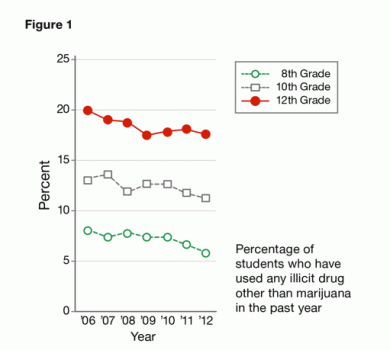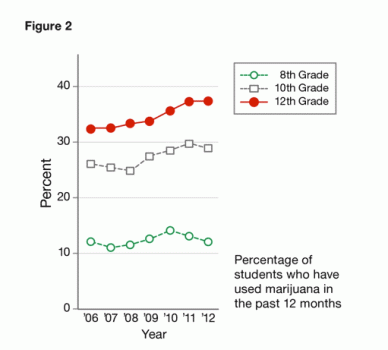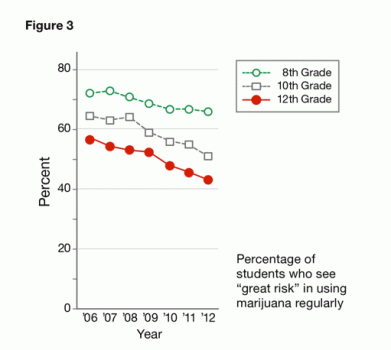The latest iteration of NIDA’s annual Monitoring the Future (MTF) survey brought welcome news of declines in use of cigarettes, most illicit drugs, and alcohol among 8th-, 10th-, and 12th-grade students. In 2012, cigarette smoking fell to its lowest rate in the survey’s history for each grade level. Use of inhalants, amphetamines, cocaine, and hallucinogens all receded.
Alcohol use decreased across nearly all the prevalence intervals of lifetime, past-year, current, and binge use. Despite much notoriety, the stimulants called “bath salts,” included for the first time in this survey, were used by only 1.3 percent of 12th graders and less than 1 percent of students in lower grades.
Marijuana: Troubling Trend
Drops in the use of most drugs confirm the effectiveness of prevention efforts, says NIDA Director Dr. Nora D. Volkow. However, cannabis use diverged from the otherwise desirable trends seen in the survey. Among seniors and sophomores, past-year and past-month use prevalence were near 5-year highs: 36.4 and 22.9 percent, respectively, among 12th graders; 28.0 and 17.0 percent, respectively, among 10th graders. Daily cannabis use was similarly high compared to past years, reported by 6.5 percent of seniors, 3.5 percent of 10th graders, and 1.1 percent of 8th graders.
One bright spot in the marijuana data was a small but statistically significant tailing off of use among 8th graders, from 13.7 percent in 2010 to 11.4 percent in 2012. Whether this dip develops into a lasting trend remains to be seen. A worrisome sign that it may not is that only 41.7 percent of 8th graders said that occasional marijuana use is harmful. This continues a 5-year downward slide in that indicator, which in the past has predicted that actual use is about to move in the opposite direction. Among sophomores and seniors, 20.6 and 26.8 percent, respectively, saw occasional cannabis use as very risky—the lowest percentages in decades.
Dr. Volkow notes that students are reporting less perception of risk from marijuana even as scientific evidence mounts that cannabis can cause serious harm. She points, for example, to a NIDA-funded large study, released earlier this year, in which regular cannabis use beginning in one’s teens and persisting well into adulthood was associated with a decrement of about 8 points in IQ at age 38.
Questions about use of so-called synthetic marijuana (e.g., “Spice,” “K-2”) use were added to MTF in 2011 for 12th graders and all three grade groups in 2012. Among 12th-grade survey respondents in 2012, 11.3 percent reported using these products in the past year.
Nonmedical Prescription Drug Use Still a Concern
After marijuana and synthetic marijuana, prescription and over-the-counter medications continue to be the drugs most abused by 12th graders. However, students reported less use of prescription opioids, tranquilizers, and sedatives than in recent years. Twelfth graders’ prevalence rates of past-year Vicodin and OxyContin use were 7.5 percent and 4.3 percent, respectively. The nonmedical use of stimulants also was down overall, with 8.2 percent of high school seniors reporting that they took nonprescribed amphetamines, 7.6 percent took nonprescribed Adderall, and 2.6 percent took nonprescribed Ritalin. (See this infographic (PDF 221KB) for more information.)
What is at stake in the MTF data was vividly represented by Chris Leibowitz, a 25-year-old Virginia man in recovery from drug addiction. Mr. Leibowitz recounted that he first tried marijuana at age 13, then moved on to cocaine, Vicodin, OxyContin, and heroin. He eventually ended up in jail for dealing drugs to support his habit. Fortunately, Mr. Leibowitz broke the cycle in rehab 3 years ago, and has been sober since then. He is working toward a career in social work and looks forward to helping other youths avoid the pitfalls of drug abuse.
Further details on the survey are available at www.monitoringthefuture.org.


